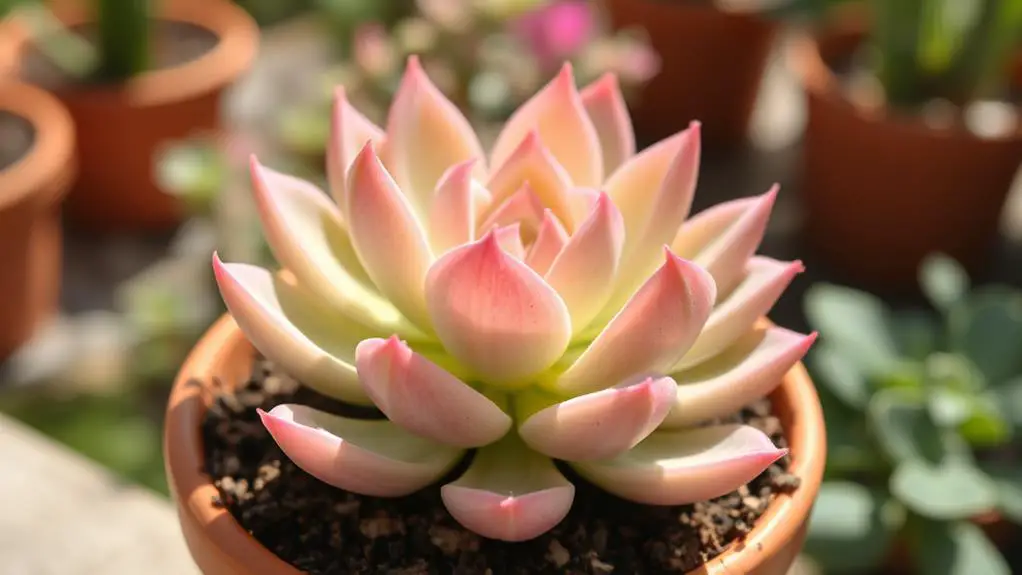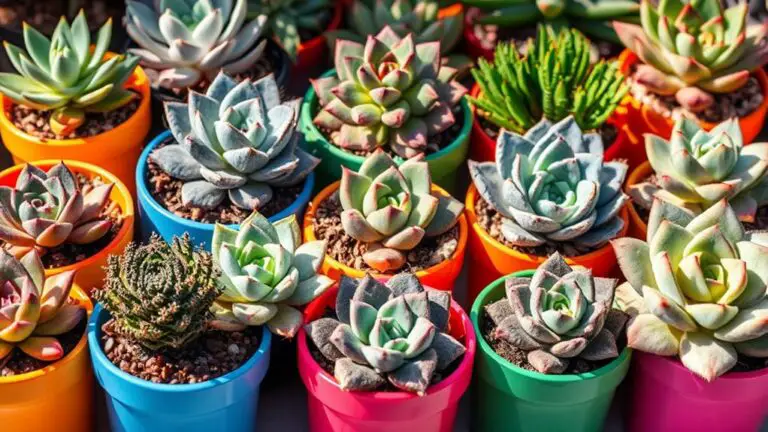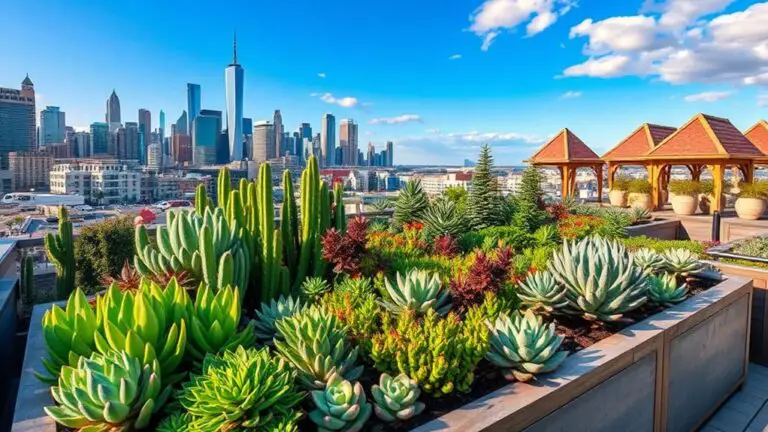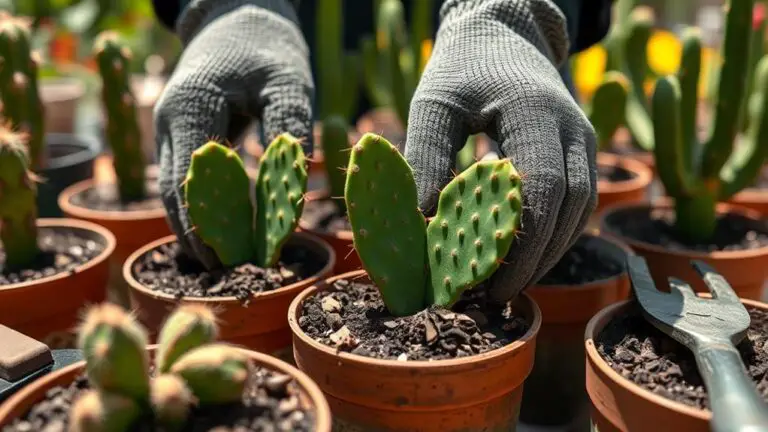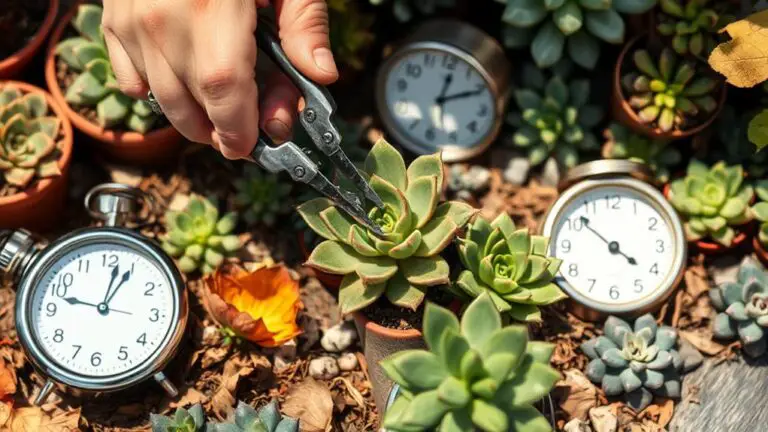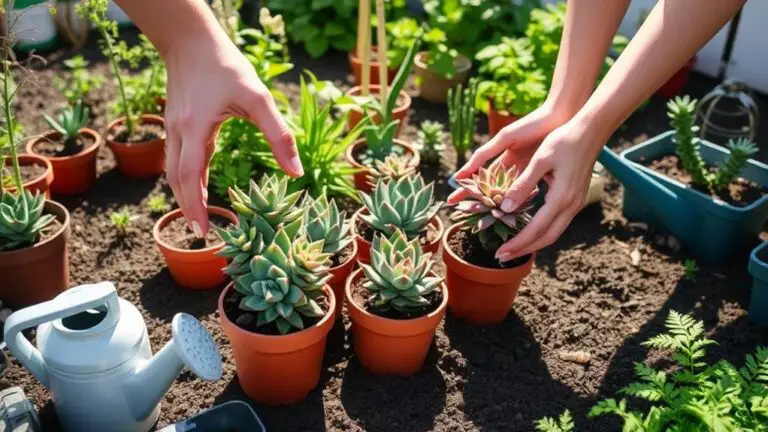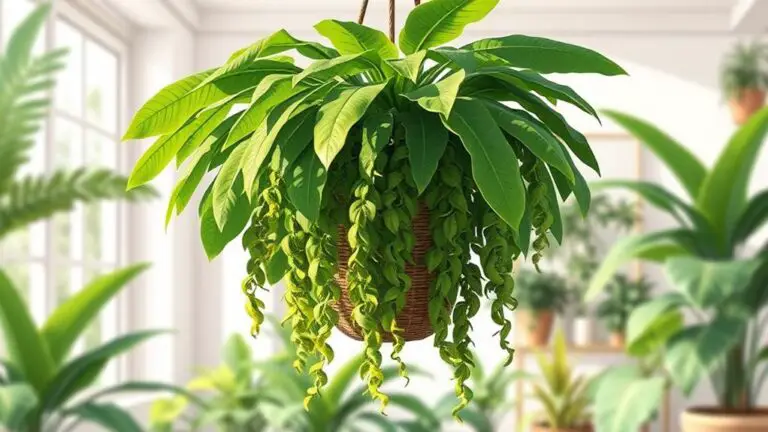How to Care for Graptoveria Bashful: A Comprehensive Guide
When you're looking to care for your Graptoveria Bashful, start by understanding its light requirements to guarantee it thrives. You'll need to provide at least six hours of direct sunlight each day, but that's just the beginning. The right soil, watering techniques, and attention to temperature and humidity are equally important. If you're curious about the best soil types, how to avoid common issues like overwatering, and tips for successful propagation, you're in the right place. Let's explore the steps to keep your Graptoveria Bashful healthy and vibrant.
Light Requirements
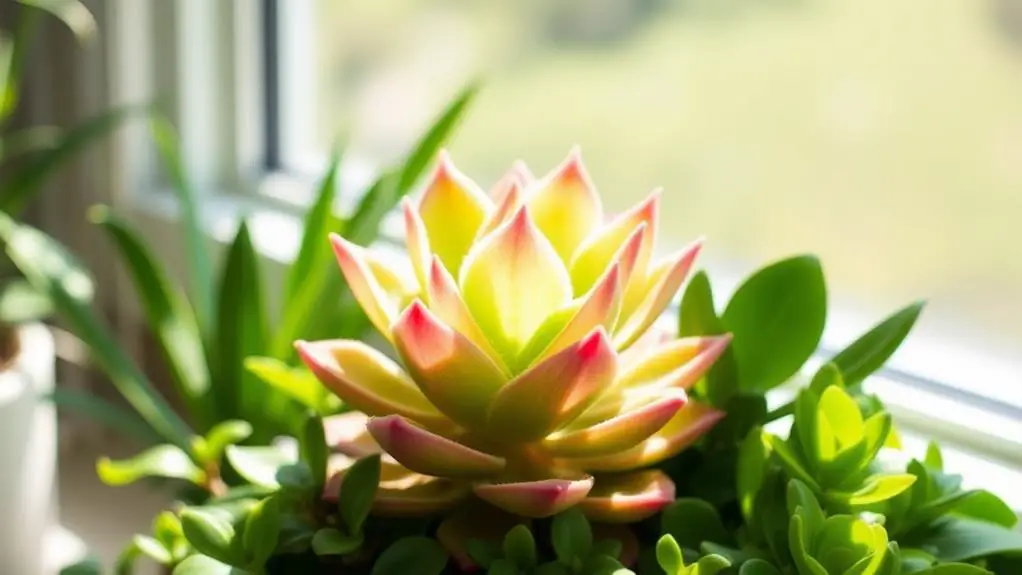
Ensuring Graptoveria Bashful gets the right light is essential for its health and vibrant color. This succulent thrives when it receives at least 6 hours of direct sunlight daily. To achieve this, place it within 1 foot of a south-facing window. This location provides the bright sunlight it needs to maintain its beautiful hues.
However, while Graptoveria Bashful enjoys bright sunlight, it's important to monitor light conditions regularly. Too much direct sunlight for extended periods can cause leaf burn. If you notice the leaves starting to look scorched, consider moving the plant slightly away from the window to reduce exposure.
On the other hand, insufficient light can lead to leggy growth and a loss of color. If your plant starts stretching out or losing its vibrant tones, it mightn't be getting enough light. You may need to move it closer to a window or find a brighter spot.
Seasonal changes and regional weather also affect light availability. In winter, you might need to adjust the plant's position to maximize sunlight exposure.
Watering Guidelines
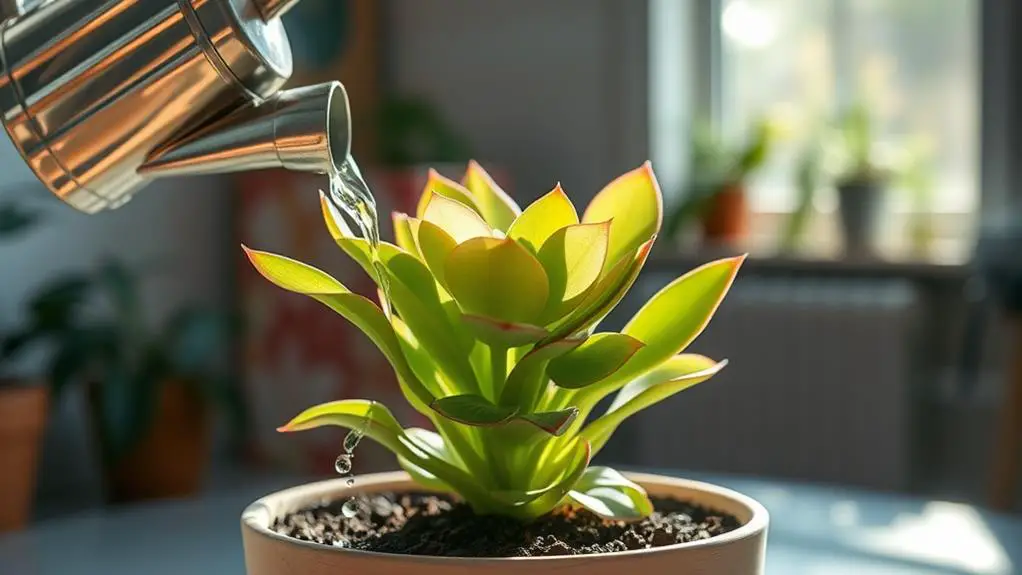
Watering Graptoveria Bashful properly is vital to its health. Using the right watering guidelines helps your succulent thrive. Graptoveria Bashful prefers a soak and dry method. This means you should water it thoroughly and then let the soil dry out completely before the next watering. Typically, about 0.5 cups of water every 12 days works well, but always check the soil first.
It's important to use well-draining soil. Overwatering is a common mistake and can cause root rot, which happens when the roots sit in water for too long. Make sure your pot has drainage holes and never leave the plant in standing water for more than a day.
Watch for signs of underwatering, like shriveling leaves and stunted growth. If you see these signs, it's time to water your plant. Smaller pots dry out faster, so you might need to water them more often to avoid drought stress.
During winter, reduce watering since the plant's growth slows down. This prevents overwatering and keeps your Graptoveria Bashful healthy.
Soil and Fertilization
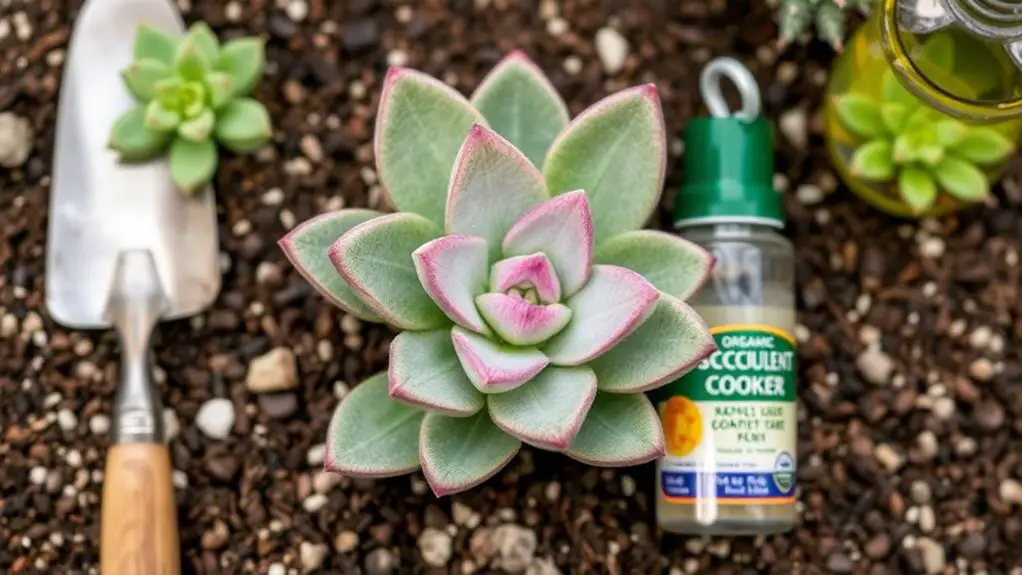
Selecting the right soil is essential for keeping your Graptoveria Bashful in top condition. This succulent thrives in well-draining potting soil, so consider using a commercial succulent or cactus mix. These types of soil prevent moisture retention and root rot, which are common problems with heavier soils.
Always avoid using garden soil since it retains too much moisture and can lead to root issues.
When potting your Graptoveria Bashful, make certain the container has drainage holes. This allows excess water to escape, further preventing root rot. It's also a good idea to replace the soil annually. Over time, the nutrients in the potting soil can deplete, so fresh soil helps keep your plant healthy.
Fertilization isn't strictly necessary but can boost growth. If you choose to fertilize, use a diluted succulent-specific formula during the active growing season, typically spring and summer. Avoid fertilizing in the winter months when the plant is dormant.
Regularly monitor the soil's texture and check for compaction. If your plant doubles in size or shows signs of nutrient depletion, it might be time to repot.
Following these tips will guarantee your Graptoveria Bashful stays healthy and vibrant.
Temperature and Humidity
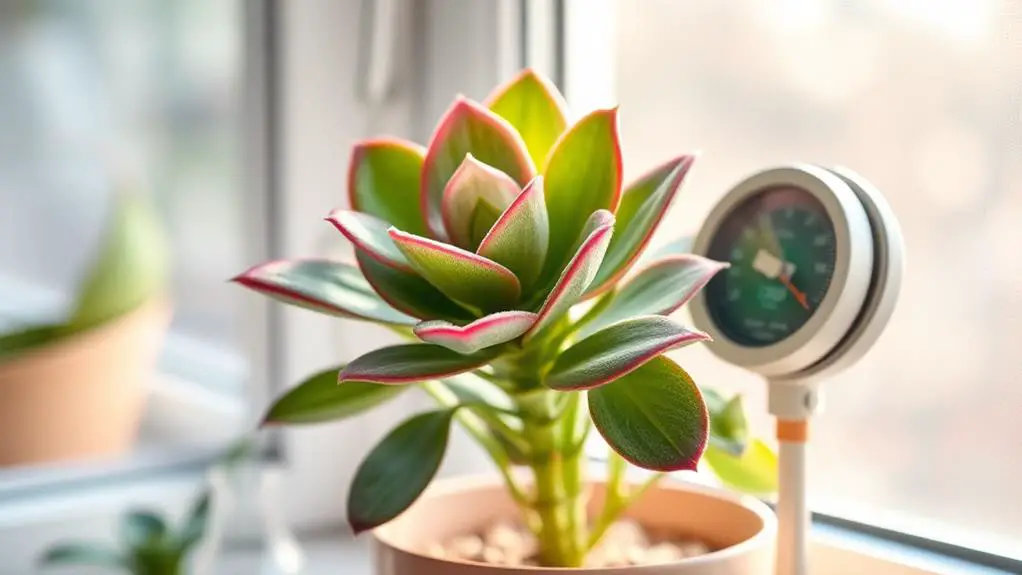
Maintaining the right temperature and humidity levels is vital for the health of your Graptoveria Bashful. This succulent thrives in temperatures between 65°F to 80°F, making it perfect for indoor environments with stable warmth.
However, it can't withstand freezing temperatures below 32°F, so you'll need to protect your plant from frost during colder months. If you live in an area with cooler temperatures, consider bringing your Graptoveria Bashful indoors or using a frost blanket to keep it warm.
Humidity levels play an important role in your plant's well-being. Aim for a humidity range of 30-50%, which helps maintain its health and promotes vibrant growth.
Too much humidity can lead to rot or fungal issues, so good airflow is vital. Make sure to place your plant in a well-ventilated area, especially if your environment tends to be more humid.
Additionally, keep an eye on seasonal temperature changes, as these can affect your plant's coloration and overall health. Monitoring these environmental factors will help guarantee your Graptoveria Bashful stays happy and healthy year-round.
With the right care, you'll enjoy a beautiful and thriving succulent.
Common Issues
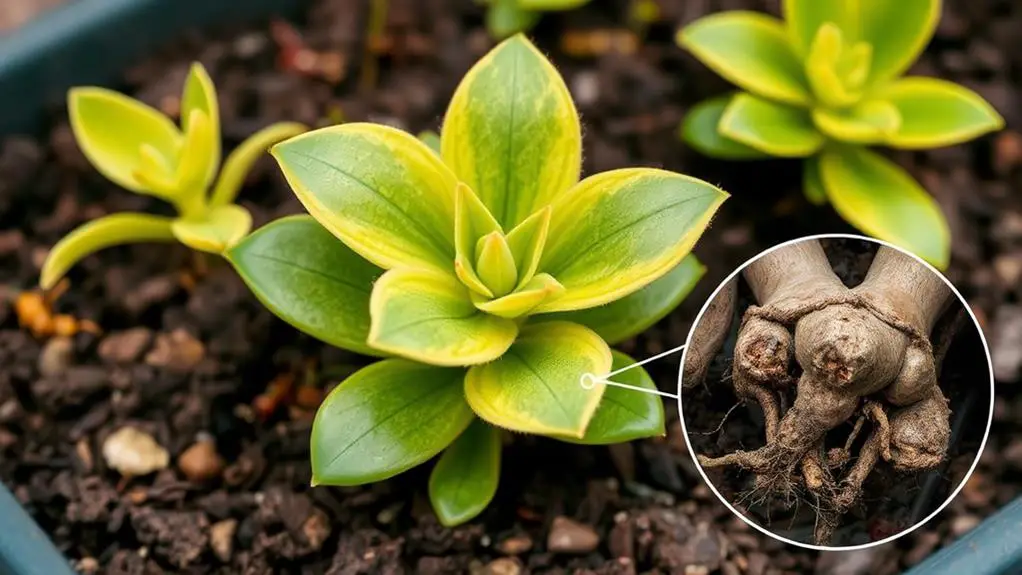
When caring for your Graptoveria Bashful, you might encounter a few common issues.
Overwatering can cause root rot, which shows up as yellowing leaves and a mushy texture, so let the soil dry out completely between waterings.
Also, watch for pests and diseases, as signs like drooping leaves or discoloration usually mean you should check for trouble and adjust your care routine accordingly.
Signs of Overwatering
Overwatering is a common issue for Graptoveria Bashful, and it's important to recognize the signs early. One of the first signs of overwatering is yellowing leaves. These leaves might look mushy or even transparent, which points to developing root rot.
Another clear indication is the texture of the leaves. If they become soft and squishy, it's a red flag. You might also notice a foul odor coming from the roots.
If the base of your plant appears to be wilting or the stems are drooping, it's another critical sign of overwatering. To prevent this, regularly monitor the soil moisture. If the soil stays damp for too long, root rot can set in, which is very harmful to your plant.
To avoid these issues, always let the soil dry out completely between waterings and use well-draining soil. Well-draining soil helps keep the roots healthy by ensuring they don't sit in water for too long.
Pests and Diseases
Although Graptoveria Bashful is a hardy succulent, it's not immune to pests and diseases that can compromise its health. Pests like mealybugs and aphids can be a real nuisance. These tiny insects suck the sap from the leaves, causing discoloration and stunted growth. You might notice sticky residue (honeydew) or even webbing on the leaves.
To combat these pests, you can use insecticidal soap or neem oil. Regularly inspecting your plant for yellowing or drooping leaves can help you catch infestations early.
Overwatering is another common issue that leads to fungal diseases. High humidity and too much water can cause leaf rot, making the leaves mushy and weak. It's essential to let the soil dry out completely between waterings to prevent this problem.
If you notice any leaves with a mushy texture, remove them immediately to stop the spread.
Quarantining new plants before you add them to your collection is a smart move. This practice can prevent the spread of pests and diseases to your Graptoveria Bashful.
Propagation Techniques

Propagating Graptoveria Bashful is a straightforward and rewarding process, perfect for beginners and seasoned enthusiasts alike. You can propagate this charming succulent by separating rosettes or taking stem cuttings. It's an easy and enjoyable way to expand your plant collection.
First, carefully separate the rosettes or snip off a healthy leaf cutting from the main plant. Allow the cut ends to callus for about one week; this step is essential to prevent rot.
Once callused, plant them in pre-moistened soilless media, like a succulent potting mix, to promote healthy roots. This mix provides an excellent environment for successful rooting.
Keep an eye on the temperature during propagation. Cooler conditions can bring out brighter tones in the leaves, making your Graptoveria Bashful even more stunning. Minimal care is required—just make sure the media stays slightly moist but not waterlogged.
With patience and a bit of attention, you'll start to see new growth. By early to midsummer, your propagations should be well-rooted and may even begin to flower.
This easy process guarantees you have more beautiful succulents to enjoy or share with friends. Happy planting!
Frequently Asked Questions
How Do You Care for a Bashful Succulent?
You'll need to give it full sun, water infrequently, and use well-draining soil. Keep temperatures between 65°F to 80°F. Fertilize every 4-6 weeks during the growing season, but skip it in winter.
How Do You Care for a Graptoveria Porcelain Plant?
Place your Graptoveria Porcelain in bright sunlight for at least 6 hours daily. Water using the soak and dry method every 12 days. Use well-draining soil, fertilize every 4-6 weeks during the growing season, and maintain moderate temperature and humidity.
How Do You Care for a Graptoveria Debbie?
To care for a Graptoveria Debbie, give it bright, direct sunlight for at least 6 hours daily. Use well-draining soil, water only when dry, fertilize every 4-6 weeks, and keep it in temperatures between 65°F and 80°F.
Is Graptoveria Bashful Toxic to Cats?
Graptoveria Bashful isn't toxic to cats, so you don't need to worry about them nibbling on it. However, keep it out of their reach to avoid any potential mess or minor skin irritation from the sap.
Conclusion
Caring for your Graptoveria Bashful is a rewarding experience that can bring vibrant colors into your home. Just remember to give it plenty of sunlight, water it properly, and keep an eye on the temperature and humidity. With well-draining soil and occasional fertilization, your plant will thrive. Don't forget to watch for pests and signs of overwatering. By following these simple steps, you'll enjoy a healthy and beautiful succulent that's easy to propagate and share.

